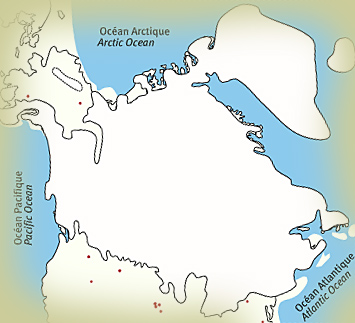|
First Peoples >
An Aboriginal Presence >
Our Origins >
Archaeology >
At the Edge of the Ice >
Full Glacial: 18,000 years ago
|
|
|
An Aboriginal PresenceOur OriginsArchaeology - At the Edge of the IceFull Glacial: 18,000 years ago - At the height of the last Ice Age, glacial ice covered nearly all of Canada and much of Europe and Asia. With much of the earth's water locked up in ice, sea levels were lowered worldwide by about 100 metres. This exposed shallow seabeds off the East Coast of North America, as well as a land bridge between Alaska and Siberia, in the heart of a region known as Beringia. Beringia remained free of ice because the climate was very dry. Archaeological evidence suggests that people had spread across Beringia from northeastern Asia into unglaciated portions of Alaska and the Yukon Territory sometime before 18,000 years ago. People may have also been living elsewhere in North America south of the glacial ice at this time - an issue that continues to be hotly debated by archaeologists today. 
Northern North America, Full Glacial, 18,000 years ago Full Glacial: 18,000 years ago Late Glacial: 11,000 years ago Early Postglacial: 8,000 years ago Middle Postglacial: 5,000 years ago Late Postglacial: 1,000 years ago |